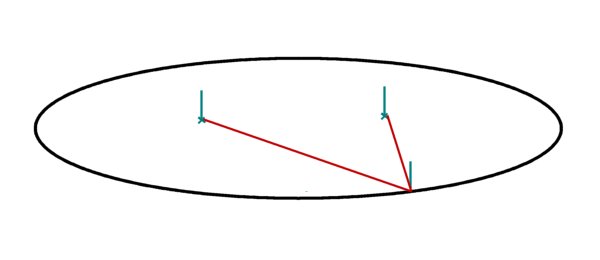Found on a website that has a crop circle page:

|
i.e.:
"In general, the "crop circles" are not perfectly round in ellipse [sic]. A fake requires a central spot to make a circle and it would be a bit more complex to makde an ellipse."
The page is written in an apparent "neutral" tone of appearance, seeming not to take sides. But the author does take sides since he believes that there are "fake" crop circles and "genuine" crop circles. The page contains many unfortunate claims, and this one is one of thoset.
I was also granted an "argumentation" about elliptic crop circles by someone, towards 2005 or 2006, on a so-called "ufology" web mailing lists. The person, who however ensured being in the field of draftsmanship, had convinced himself that to trace an ellipse in a field verges on the impossible.
Thus, it seems that there are people who find that whereas it is not really complicated to make a circular crop circle, to make an elliptic crop circle would be "a little more complex", or would be difficult or impossible enough so that an ellipcital crop circle would not be made by people.
First fact:
There are almost no elliptic crop circles. I do not know even a single crop circle for which there would be the least evidence than it would not have been made by men.
Second fact:
To trace an ellipse in a field is childishly easy!
To make a circle, the artists who make the crop circles generally go by two. One stands at the spot that will be the center of the circle, holding a cord or a ribbon. The other tightens the cord or the ribbon, standing at the other end, and turns around the first one. It is very simple.
The artists who make crop circles all alone are rather rare. But it is possible to make a circular crop circle all alone. The initial technique was to plant a stake to mark the center and to attach one end of the cord to it.
When done, the stake is withdrawn and the small hole it made closed again by hand. As the "crop circles experts" do not really seek evidence of human manufacture, this was enough to make them say that "there is no hole", even when the hole was not closed!
Another technique, which does not leave any chance to find a stake hole, even when looking for it, is to tie the cord or the ribbon at a weight just posed on the ground. This is just enough - there is no need to pull like mad on the ribbon or the cord, it does not need to be extremely tighten.
What is an ellipse?
A circle can simply be regarded as one particular case of ellipse. The circle is an ellipse "with only one center". All things considered, to trace the ellipse, you just need two centers instead of one. This is done by placing two people, each one at one of the two centers, holding both end of a cord or ribbon, of which the length is higher than the distance between these centers, so that a third person marks the contour of the ellipse. Same principle with stakes.
It is all very simple. There is actually no difficulty in tracing an ellipse in a field.

|
Few crop circles are based on an ellipse, but this is not because it would be so difficult, even less impossible, it is simply, in the beginning, because the crop circles invented by Doug Bower, were supposed to be mistakingly interpreted as landing traces of flying saucers, which are obviously supposed to be circular and not elliptical. Then later, when the crop circles became a form of art, the circle was still preferred as a base for the design because the circle integrates much more easily in complex designs.
The rare people who believe that an elliptic crop circle would be suggestive or evidential of a nonhuman origin do not know what they are talking about, they did not think, and they are miselading themselves.